2012/09/01
289. zenbakia

eu es fr en cat gl
Aparecerá un contenido traducido automáticamente. ¿Deseas continuar?
Un contenu traduit automatiquement apparaîtra. Voulez-vous continuer?
An automatically translated content item will be displayed. Do you want to continue?
Apareixerà un contingut traduït automàticament. Vols continuar?
Aparecerá un contido traducido automaticamente. ¿Desexas continuar?
Bad weather in heliosphere
Text created by automatic translator Elia and has not been subsequently revised by translators.
Elia Elhuyar
The Earth is part of the Heliosphere. The light and heat of the sun and the solar wind arrive. And when the wind is strong, electronic devices begin to fail and astronauts need protection. It is a storm. The Earth has a magnetic shield that protects it and, however, it is necessary to predict the time of space.
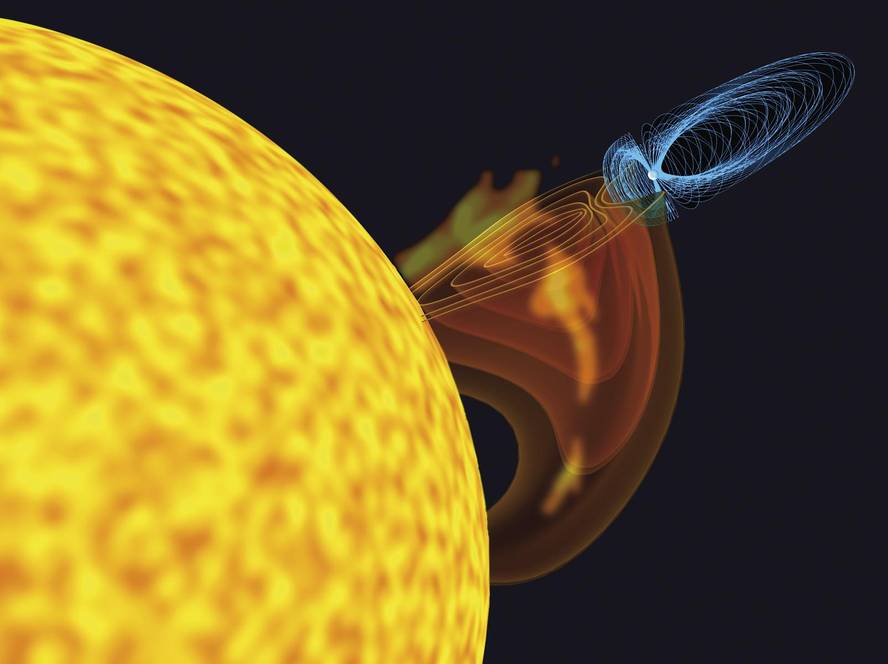
The solar eruptions deform the magnetic field of the Earth (in blue) and cause the bad time of space. Image: Image: Guillermo Roa/Elhuyar Fundazioa.
Satellites for Canadian television Ani E1 and Ani E2 failed in 1994 due to solar activity. They were geostationary -- very high orbit -- and the strong solar wind of January 20 greatly affected the electronics of satellites. The E1 satellite signal had a seven-hour interruption. And an hour after recovering the signal, an E2 gyroscope was damaged, whose function was to stabilize the orientation of the satellite and the failure caused the loss of orientation of the satellite.
For five months, the satellite could not remain looking to the Earth and had to pass the entire signal through the E1 satellite. The TV technicians had to adapt the Canadian antennas to receive the signal from the E1 satellite and spent months until, once repaired the E2, they were able to return to their initial state.
The damage caused by the solar wind can be even greater than the loss of the TV signal. Solar storms have caused blackouts, for example, on March 5 of this year there was a large type X eruption in the Sun, the strongest of all types, and the disruption of radio wave communication in Australia, China and India.
As for satellites, the GPS service stands out. Their satellites are not geostationary, but high orbit, and they are constantly being attacked by space time. According to experts, during a magnetic storm, the GPS system can have an incidence of 100 meters in positioning. The change of 100 meters is too big for activities that depend on the accuracy of the GPS: navigation, timely maintenance of marine oil platforms, topography, architecture, etc.
Time of space
The largest solar storm recorded in history was the Carrington storm in 1859. The Northern Lights caused by the storm were also seen in the Caribbean. At that time there were no satellites, but the telegraph signal was cut in Europe and North America. Today, however, such a storm would be a technological disaster.
To minimize losses, the first step would be to predict the storm. As in meteorology, permanent prediction services would be necessary.
There are predictions but they are limited. Today, the most demanding observation of the solar wind takes place in the belts of Van Hallen, two orbital zones around the Earth, where most satellites are located. But not all: many satellites of high orbit, all geostationary and others like those of the GPS system, are outside the belts of Van Hall, further away from Earth. These distant orbits present a higher risk and the current predictive capacity is insufficient. For this reason, projects to improve prediction have been launched, such as the Spacecast project of the European Union.
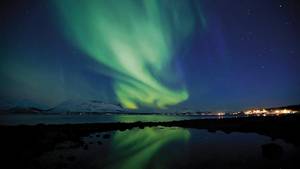
Aurora borealis. February 10, 2011. Ed. Quicheisinsane/CC BY-NC-ND
Storm of two seasons
The data of the missions to the Sun also serve to make predictions, since the magnetic storm comes in two seasons. An eruption, in addition to emitting charged particles, emits radiation. Both have a very different speed. On the way to land, the particles spend two or three days of travel. (Seventeen hours arrived in the Carrington storm.) The radiation takes only eight minutes, as it moves at the speed of light.
Therefore, in the first place, the influence of the radiation is appreciated. Unexpectedly and without anyone realizing it, the electronics of the satellites suffer the attack. The Earth's magnetic field diverts the radiation to the poles, but only to some extent; very strong magnetic storms far from the poles are remarkable. Like March 5. Suddenly, radio communications were interrupted in Asia and Oceania.
Then, approximately two hours later, the faster charged particles begin to reach Earth, the faster ones. They are few, but it is the beginning of the second season. From there, the flow of particles is not interrupted and, in two or three days, most of the charged particles arrive. This difference between radiation and particle velocities allows predicting the second wave of storm. The first season brings the announcement of the second. So they knew that on March 7 the solar wind was going to be very strong. Today, however, the accuracy of this ad is not high.
Reading neutrons
The way to fine-tune prediction systems is usually to look back in time, which has made a team of neutron detectors from the University of Delaware. We take the data from past storms and analyze whether the system is able to calculate its effect. Antarctica is a good place because the magnetic field of the Earth diverts most of the particles to the poles and it is very difficult to maintain a neutron detector in the North Pole, where there is no earth. And the detection of neutrons is also because they are indicators of solar wind. They are not charged particles, there are no neutrons in the solar wind. But the protons and electrons of the solar wind collide against atoms at the top of the atmosphere, and that is, they release neutrons.
The physics system of the University of Delaware analyzes the first particles that arrive on Earth, the beginning of the second wave, and calculates when and with what strength will most of the particles of the season arrive. For the moment, the results have been satisfactory, but they are only at the beginning of the investigation.
Weakening the shield of the Earth
The Earth's magnetic field turned the last round 780,000 years ago. Homo erectus, for example, lived this process. Since then it has not happened, but scientists calculate that this has occurred on average every 250,000 years. It would have to happen already, but is it already happening?
The simulations indicate that this is a millennial evolution. Initially the magnetic field is weakened, new magnetic poles are created, and the previous north and south magnetic poles are no longer unique. They are more poles, but weaker. And that radically changes the relationship between the Earth and the Sun. The solar wind reaches more places on Earth, radiation increases mutations in the genetic material of living beings and ecosystems change. This radiation does not produce, for example, massive disappearances, but the conditions of the Earth change. In the end, the situation goes back until only two poles remain, inverse to the initials, and the field is reinforced.
The Earth may be at the beginning of this process. In the last 150 years the magnetic field has weakened by 15%. But it may not be so.
William Dean Pesnell: "The biggest difficulty of the SDO mission is to keep data flow properly"
To predict when the solar wind will transform into a storm it is very important to constantly observe the star and obtain data of its activity. One of the missions that carry out this work is the satellite SDO, the Solar Dynamics Observatory managed by NASA. The scientific head of the mission is William Dean Pesnell, who has spoken for Elhuyar magazine about the SDO and its work:
"I work at NASA's Goddard Space Flight with scientists and engineers to keep the SDO observatory going, monitoring the transmission of scientific data for databases and working with data indicating the health of the spacecraft and its tools. Our team is in different places: Goddard, the University of Colorado, Stanford University and Lockheed Martin. That means I have to read and write many messages because we each work in our schedule.
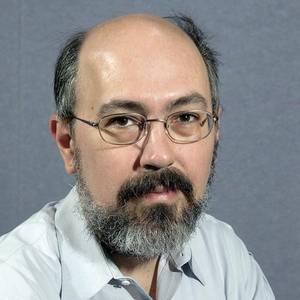
William Dean Pesnell is a physicist at NASA and scientific director of the SDO observatory. Ed. NASA ©
Since the SDO has a geostationary orbit, a single station is sufficient for the continuous collection of all data. This station is located south of New Mexico. There we collect data from SDO and distribute them to groups of scientists. If the container has another type of orbit, it should keep the data until it is transmitted in the next step over the center.
The biggest difficulty of the mission is to keep the data flow properly. So far all the problems have arisen on the floor: some blackouts, some cable cuts and time has cut the data. But despite having been, we have achieved that 99.97% of the data sent by the spacecraft are collected and stored.
An apparatus called EVE ( Extreme ultraviolet Variability Experimental ) measures a small part of the solar energy, that is, of the radiation of wavelength less than 100 nm. It is called spectral irradiance. These wavelengths vary with the activity of the Sun, especially in solar eruptions, and we must measure them in space because they are absorbed by the Earth's atmosphere.
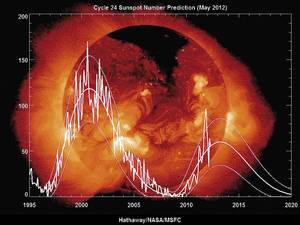
Cycles 23 and 24 of solar activity. Cycles are counted since 1755 and we are currently in the 24. In the image is represented the complete cycle 23 with the data of the current cycle and the expected evolution. Ed. NASA/msfc ©
Solar activity has a cycle of 11 years and irradiance varies approximately 0.1%. The variation is really very small, but in some wavelengths the variation is very large: They are 1000 times larger in eruptions. Therefore, the variation of all irradiance is small, but the incidence of a part is very high. Astronomers know that the Sun should not change like this. But it changes, which gives us an idea of what a cycle of 11 years supposes.
It comes from the convection zone, from an inner part of the Sun, where heat moves because the bubbles formed by hot material rise below. And the cycle arises because the movement of the material generates a magnetic field; the sun is a dynamo. These movements are very complex, so the cycle is not totally regular. The minimum cycle of "11 years" can be 9 years and the maximum of 14 years.
The SDO is three years to answer our research questions: what causes the magnetic field of the Sun, how it is destroyed and if the characteristics of the field can be predicted."
Final gift, sometimes green
Jules Verne made the green ray famous with a novel. If the sky is very clean, sometimes it is seen at sunset from the sea level: the last ray of sun is green. In the best conditions, the last two seconds approximately. A legend says that two people who see the green ray fall in love together, and Verne addressed that legend to write the novel. And by the legend and fame of the novel, it has often been questioned that the green ray is nothing more than an invention.
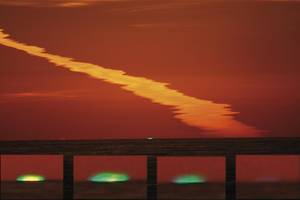
Ed. Inaglory/CC BY-SA by Brock
But the green ray is not an invention. It is an authentic optical phenomenon. Physical explanation is not complex; when light reaches a small angle, the atmosphere acts as a prism, that is, it refracts the colors of light in different directions. And in certain conditions this effect is seen. At dusk or at dawn. The spectator receives the green rays.
From time to time the refraction is so big as to see also the blue rays. It is very difficult to see the blue Sun at first glance. The green is also difficult to see, proof of this is that there are few green ray photos compared to those of sunset. The green ray is easier to see in the tropics, but when conditions are adequate, it can also be seen in larger latitudes.










